Wilson Electronics 8012SM WIRELESS CELL PHONE AMPLIFIER User Manual MOBILE INSTALLATION GUIDE
Wilson Electronics, LLC WIRELESS CELL PHONE AMPLIFIER MOBILE INSTALLATION GUIDE
Contents
- 1. Users Manual
- 2. MOBILE INSTALLATION GUIDE
- 3. INSTALLATION GUIDE
MOBILE INSTALLATION GUIDE
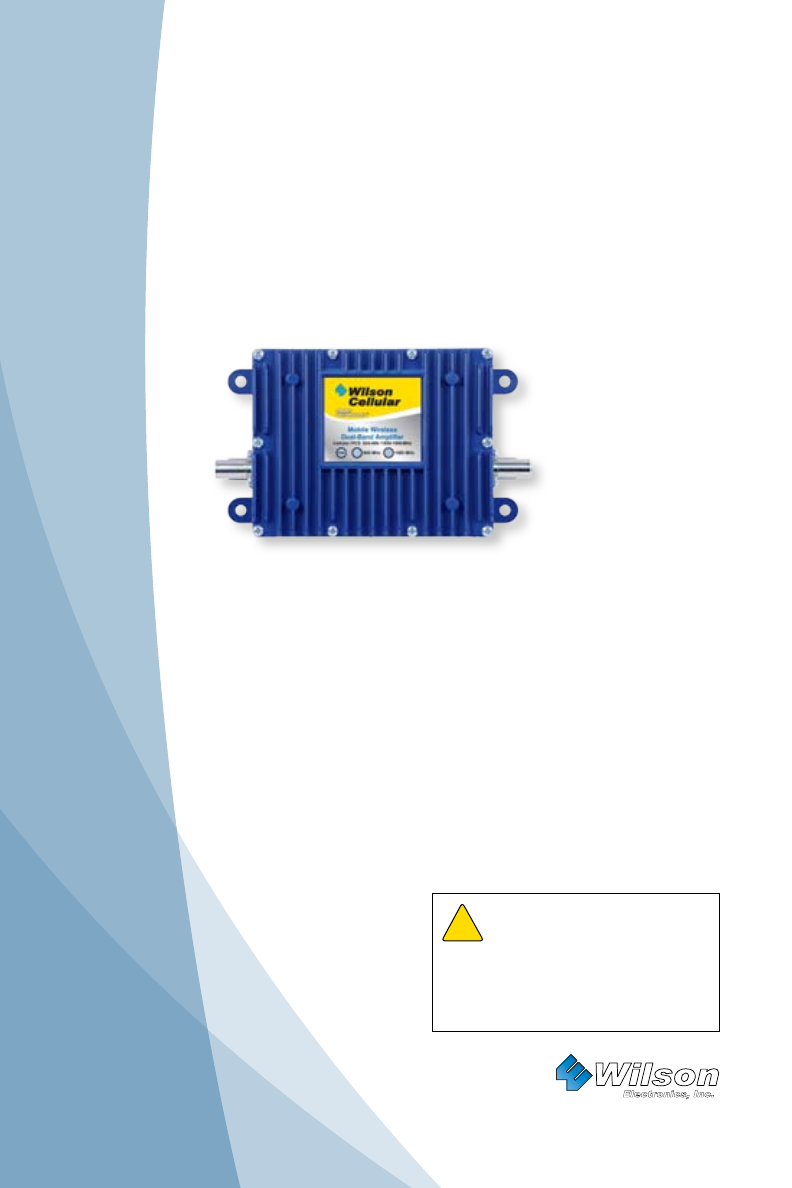
Amplifier
Installation
Guide
Mobile Wireless
Dual-Band
Cellular / PCS
Amplier
MODEL# 271245
PART# 801201
Contents:
Guarantee and Warranty · · · · · · · · · · · · · · · · · · · · · · · · 1
Before Getting Started · · · · · · · · · · · · · · · · · · · · · · · · · · 3
How it Works · · · · · · · · · · · · · · · · · · · · · · · · · · · · · · · · · 3
Installing a Wilson Outside Antenna · · · · · · · · · · · · · · · 4
Installing a Wilson Amplier · · · · · · · · · · · · · · · · · · · · · · 5
Installing a Wilson Inside Antenna (Wireless) · · · · · · · · 6
Installing a Wilson Inside Antenna (Attached) · · · · · · · · 7
Powering Up a Wilson Amplier · · · · · · · · · · · · · · · · · · · 8
Warnings and Recommendations · · · · · · · · · · · · · · · · · 9
Understanding the Amplier Lights · · · · · · · · · · · · · · · · 10
Amplier Specications · · · · · · · · · · · · · · · · · · Back Cover
Wilson
®
Electronics, Inc.
Warning: This manual contains
important safety and operating information.
Please read and follow the instructions
in this manual. Failure to do so could be
hazardous and result in damage to your
amplier.
!

1
30-Day Money-Back Guarantee
All Wilson Electronics products are protected by Wilson’s 30-day money-back
guarantee. If for any reason the performance of any product is not acceptable,
simply return the product directly to the reseller with a dated proof of purchase.
1-Year Warranty
Wilson Electronics ampliers are warranted for one (1) year against defects in
workmanship and / or materials. Warranty cases may be resolved by returning the
product directly to the reseller with a dated proof of purchase.
Ampliers may also be returned directly to the manufacturer at the consumer’s
expense, with a dated proof of purchase and a Returned Material Authorization
(RMA) number supplied by Wilson Electronics. Wilson shall, at its option, either
repair or replace the product. Wilson Electronics will pay for delivery of the repaired
or replaced product back to the original consumer.
This warranty does not apply to any ampliers determined by Wilson Electronics
to have been subjected to misuse, abuse, neglect, or mishandling that alters or
damages physical or electronic properties.
RMA numbers may be obtained by phoning Technical Support at 866-294-1660.
Disclaimer: The information provided by Wilson Electronics, Inc. is believed to
be complete and accurate. However, no responsibility is assumed by Wilson
Electronics, Inc. for any business or personal losses arising from its use, or for
any infringements of patents or other rights of third parties that may result from
its use.
Copyright © 2007 Wilson Electronics, Inc. All rights reserved.
Operation is subject to the following two conditions: (1) This device may not cause
interference, and (2) this device must accept any interference, including interference that
may cause undesired operation of this device.
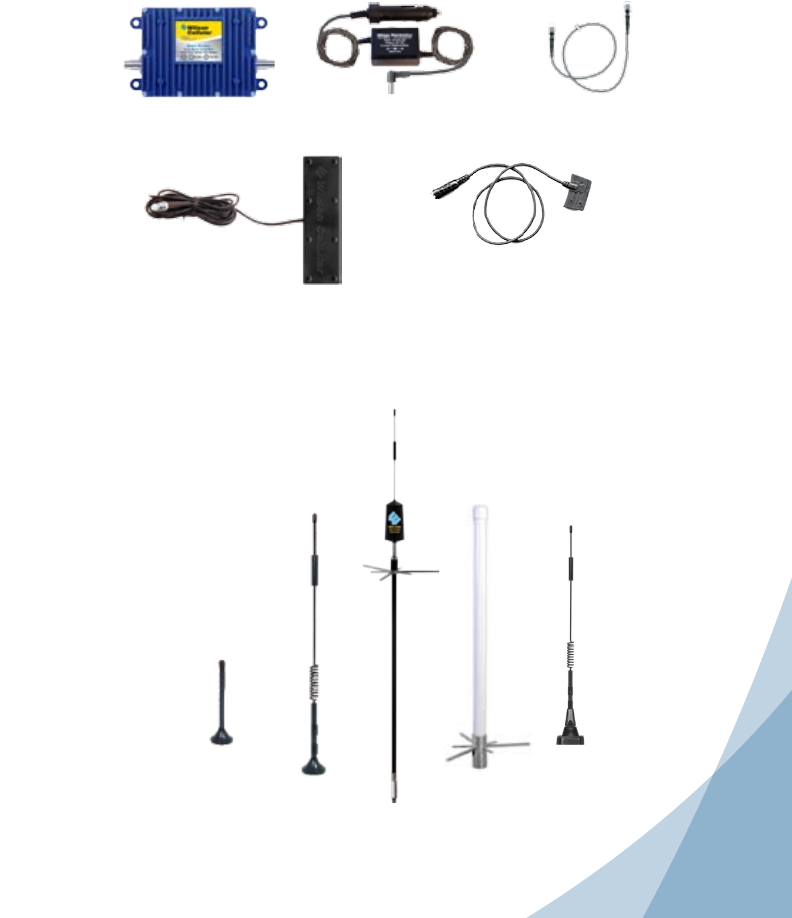
2
Installation Instructions for the Following Wilson Amplier:
Mobile Wireless Dual-Band Amplier
Model # 271245, Part # 801201
FCC ID: PWO8012SM IC: 4726A-8012SM
The term “IC” before the radio certication number only signies that Industry Canada
technical specications were met.
Inside this Package
Additional Required Equipment (sold separately)
• Outside antenna
Wireless
amplier
DC plug-in power
supply
Low-prole
antenna
(Option A - see p. 6)
Universal
Connector
(Option B - see p. 7)
6‘ extension
cable
NMO
Mount
Dual-BandMagnet
Mount
Dual-Band Trucker
Mount
Dual-Band
Mini
Magnet
Dual-Band Marine
Antenna
Dual-Band
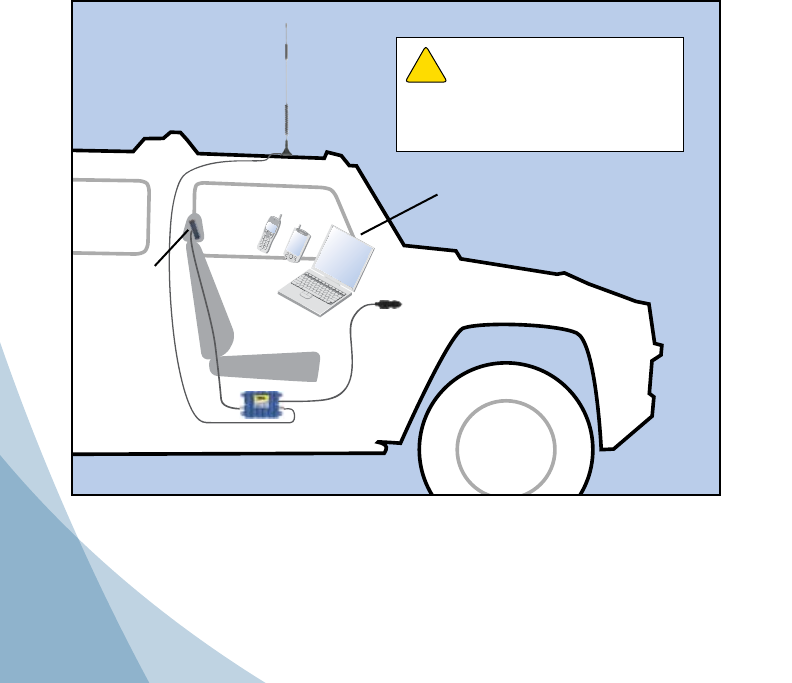
3
Before Getting Started
This guide will help you properly install Wilson’s dual-band, mobile wireless amplier. It is
important to read through all of the installation steps for your particular application
prior to installing any equipment. Read through the instructions, visualize where all the
equipment will need to be installed and do a soft installation before mounting any equipment.
If you do not understand the instructions in full, seek professional help, or contact Wilson
Technical Support at 866-294-1660.
How it Works
Wilson ampliers are small, portable, bi-directional devices that deliver cellular service levels
consistent with what would be expected in areas of high cell network coverage. They amplify
a weak or shadowed signal in vehicle, marine and in-building applications.
When using a Wilson amplier in conjunction with Wilson antennas, the outside antenna will
collect the cell tower signal and send it through the cable to the amplier. The signal is then
amplied and broadcast from the inside antenna to the surrounding area. Cell phones and
cellular data cards (laptops) in that area then communicate with the improved signal. When
a cell phone or cellular data card transmits, the signal is received by the inside antenna,
amplied by the amplier and broadcast back to the cell tower through the outside antenna.
Installation Diagram
Warning: In a wireless installation,
do not plug the amplier directly into the
cell phone or data card using an antenna
adapter. It will damage the amplier.
!
Outside
Antenna
Inside
Antenna
Amplier
DC Power
Supply
Cell Phone
PDA
Notebook
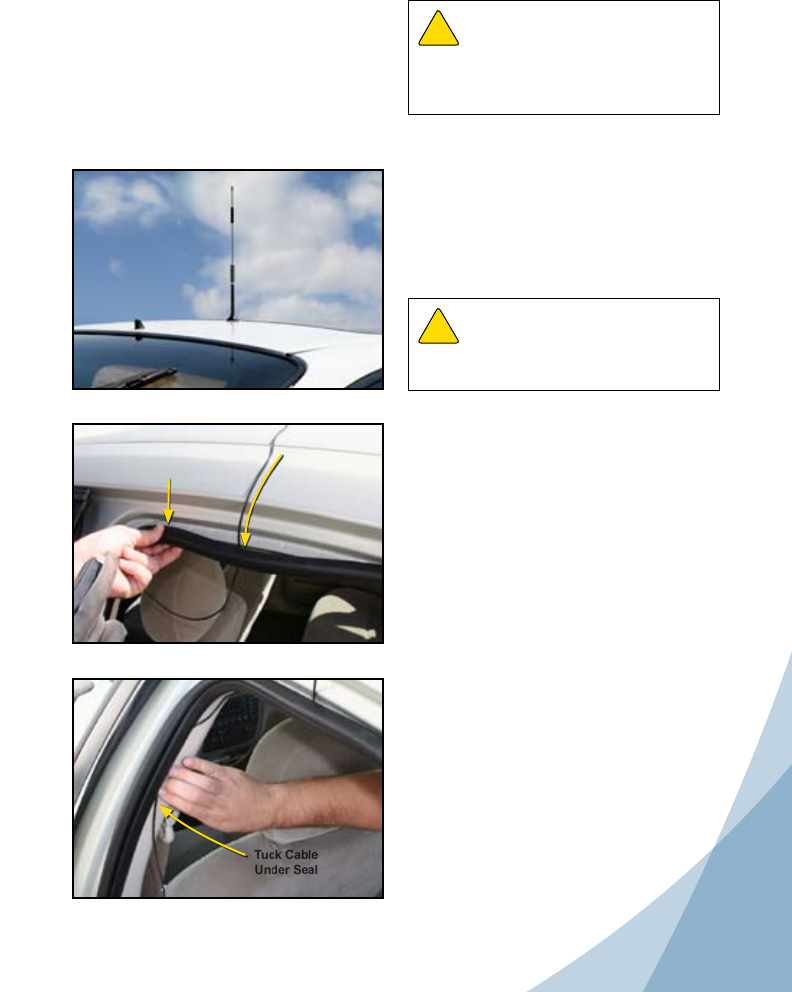
4
Installing a Wilson Outside Antenna
To receive the best cell signal, select a location in the center of the vehicle’s roof 12 inches
away from any other antennas and free of obstructions.
Follow the specic antenna installation instructions included with the outside antenna (sold
separately).
The outside antenna must be installed
vertically. Signal performance will be
degraded if the antenna is not vertical.
The antenna cable may be run through the
door to the amplier.
The antenna cable is small enough to easily
tuck under the door seal or plastic molding.
For a more professional-looking installation,
the antenna cable may be run under the
door seal. Carefully pull down the door
seal. Run the cable through the seal
and push the seal back into place. This
prevents constant wear and tear on the
cable as the door opens and closes.
Warning: Do not use any type of glass-
mount antenna with this amplier. The outside
and inside antennas must be shielded from
each other to prevent oscillation.
!
Optional Magnet-
Mount Antenna
Shown
Part #301103
Carefully
Pull Down
Door Seal
Run Cable
Under
Seal
Tuck Cable
Under Seal
Warning: The outside antenna must
have a separation of at least 10 inches from all
persons during normal operation.
!
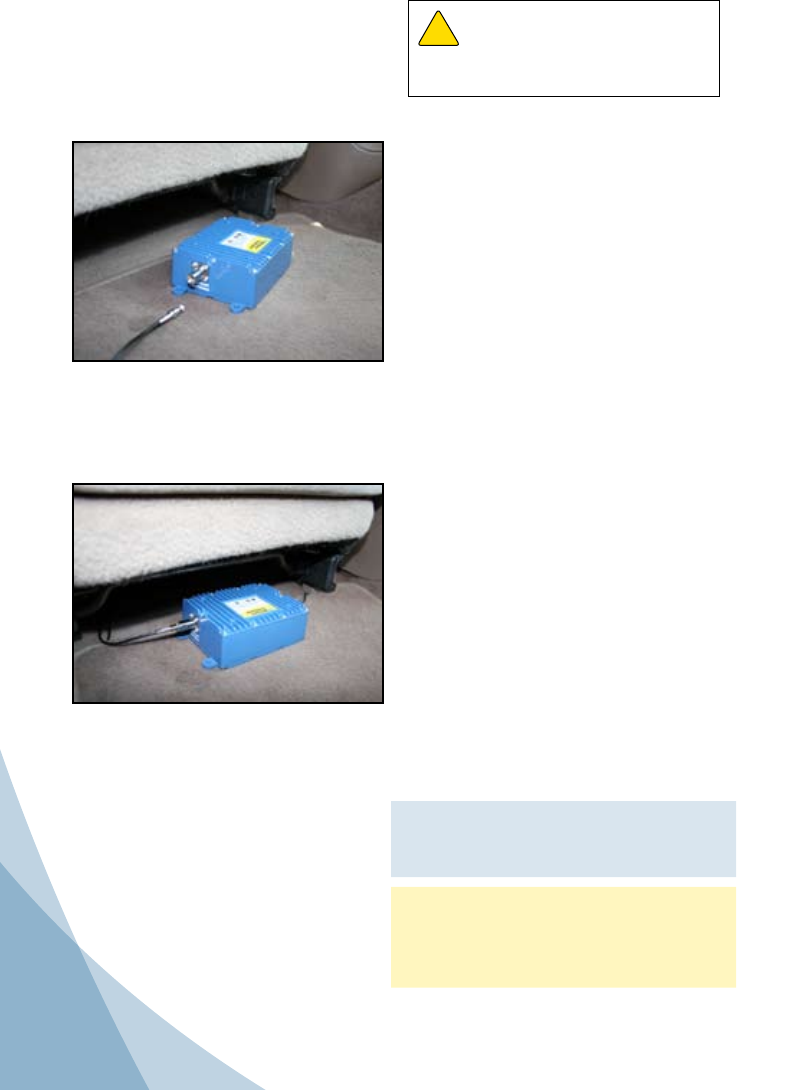
5
Installing a Wilson Amplier
Warning: Do not plug in the DC power
supply until the outside and inside antenna
cables are attached to the amplier.
!
Wilson offers two options of improved signal
inside a vehicle:
Option A (Wireless) - offers the
convenience of no physical connection to
the cell phone or cellular data card.
Option B (Attached) - places the universal
connector directly on the cell phone or
cellular data card for maximum signal
performance.
Select a location to install the amplier that
is away from excessive heat, direct sunlight
or moisture and that has proper ventilation.
Recommended installation locations are:
•Under the seat
•In the trunk
•Under the dash
Run the cable from the outside antenna and
attach it to the FME-Male connector labeled
“outside antenna” on the amplier.
Attach the inside antenna cable to the FME-
Male connector labeled “inside antenna” on
the amplier.
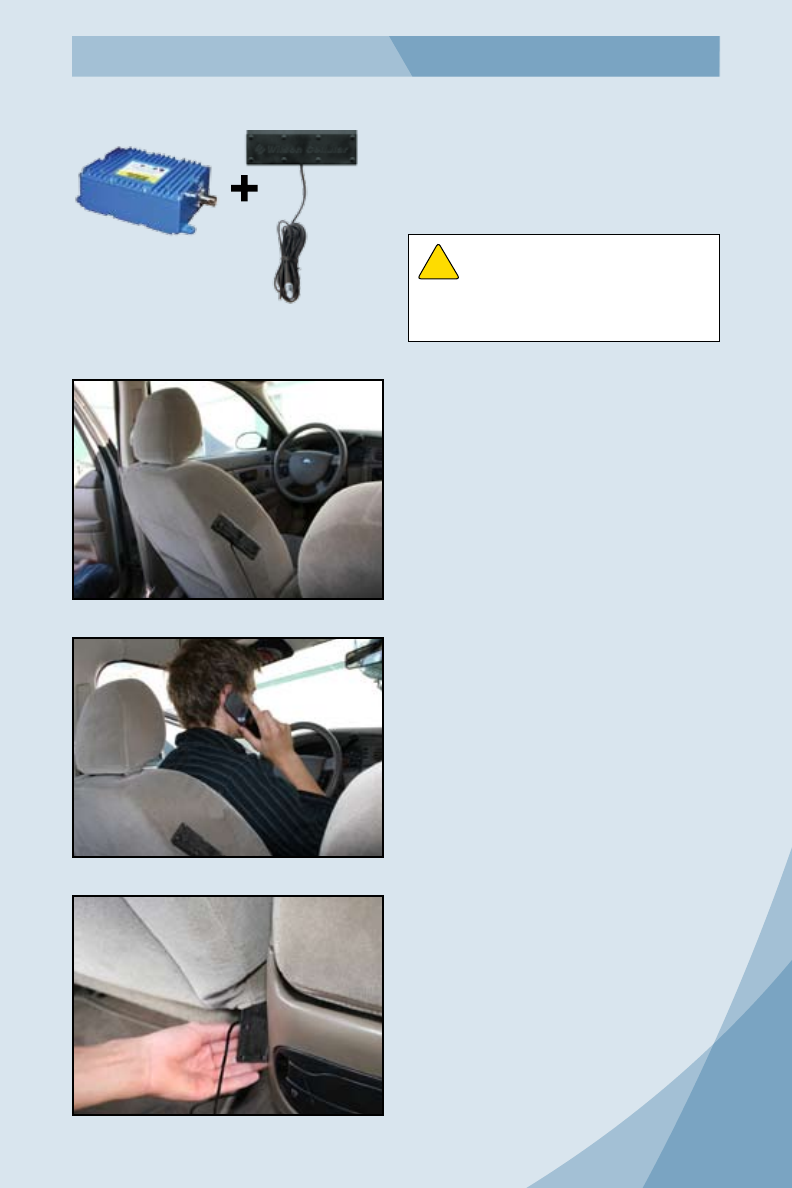
6
For optimal performance, install the low-
prole inside antenna within a foot from
where the cell phone or cellular data card will
be used.
Place the inside antenna at shoulder height
on the side of the driver’s seat for maximum
performance.
Install the inside antenna at the same angle
as the cell phone when held in use, or place
next to the laptop’s cellular data card. This
will maximize the signal strength.
For a more professional-looking installation,
the low-prole antenna may be slid under
the seat cover or leather, high on the
driver’s seat.
The low-prole antenna must have a
separation of at least eight inches from all
persons during normal operation.
Warning: Do not install the low-prole
antenna within four inches of metal. (Metal
found inside the vehicle’s seat will not affect
the antenna’s performance.)
!
Amplier
Low-prole
Antenna
Installing a Wilson Inside Antenna
Option A (Wireless)
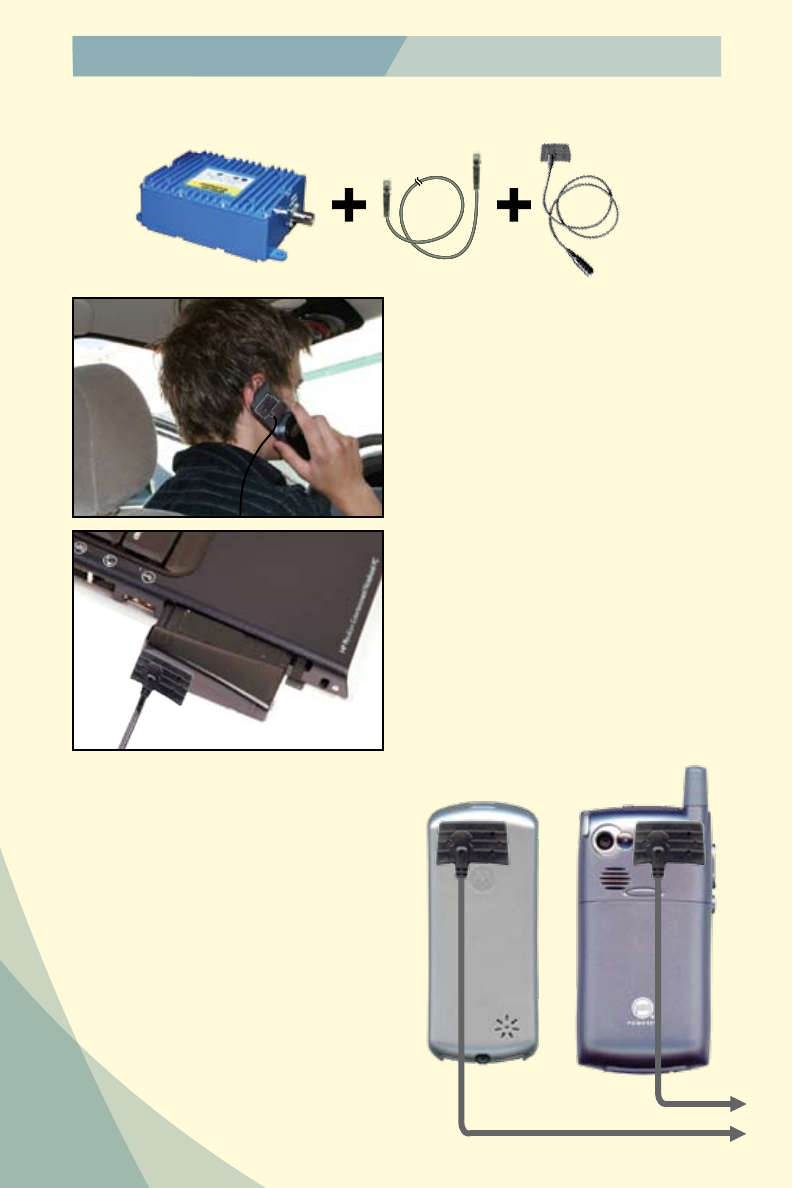
7
The universal connector must be placed
directly on the cell phone or cellular data
card to work properly. Attach the universal
connector to the cell phone or cellular data
card with the VELCRO® included in the
package.
The universal connector and extension
cable included in the package are long
enough to reach the amplier location. This
allows for ease and convenience of use.
To adjust the universal connector for the
best signal, go to a weak signal location
where your cell phone registers only 1-
2 bars without the universal connector
connected. Then, attach the universal
connector to the phone and you should see
a signal improvement of 2 or more bars.
NOTE: Many phones take up to 20 seconds
to reset the bar indicator.
To maximize performance, attach the
universal connector as close as possible to
the original antenna on your cell phone or
cellular data card.
For cell phones with an internal antenna,
place the universal connector on the back,
upper left-hand corner of the phone. (Figure
1) NOTE: Certain phones, such as the
Motorola RAZR, have internal antennas at
the base, rather than the top, in which case
the universal connector should be attached
at the bottom rear of the phone.
For cell phones with an external antenna,
place the universal connector directly below
the phone’s original antenna. (Figure 2)
If you have any questions as to the location
of the antenna on your phone, call Wilson
Technical Support at 866-294-1660 or visit
www.wilsonelectronics.com.
Amplier 6’ Extension
Cable Universal
Connector
Figure 1 Figure 2
To Amplier
Installing a Wilson Universal Connector
Option B (Attached)
Cellular data card
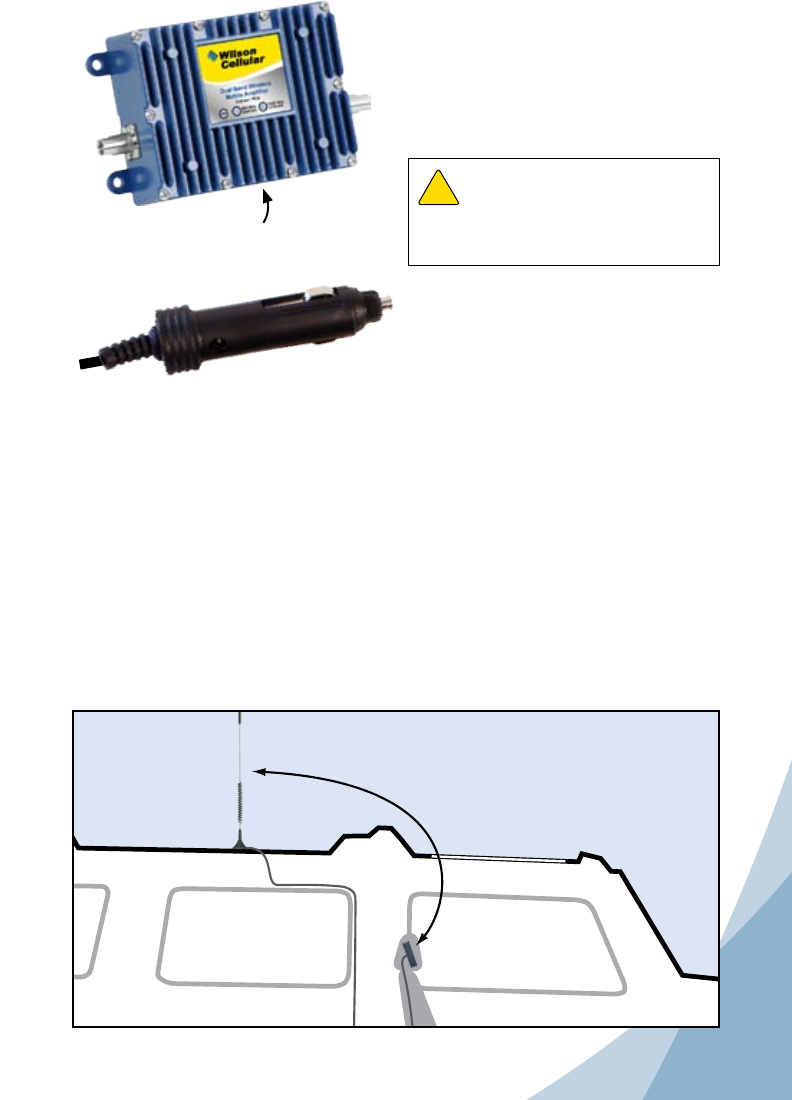
8
Powering up a Wilson Amplier
Make sure both the outside and inside
antenna cables are connected before
powering up the amplier.
Connect the power cable from the DC
plug-in power supply to the amplier
marked “Power” and insert the large end
into DC power socket (the cigarette lighter
outlet.)
The amplier may remain on all the time.
However, leaving the amplier on in a
vehicle when it is not running can discharge
the battery in a day or two.
A good option is to power the amplier
through the ignition switch so the amplier
is turned on and off with the vehicle.
NOTE: The aluminum casing of a Wilson amplier will adjust very quickly to the ambient
temperature of its environment. For example, in the summer, when the inside of a car can
reach 140 degrees Fahrenheit, the amplier temperature may be 150 degrees or higher.
The casing will be hot to the touch, similar to a metal door handle or a steering wheel. Such
high temperatures will not damage the amplier, nor do they pose a re risk to the vehicle.
As recommended in these instructions, install the amplier in a location with adequate
ventilation, such as under the seat, in the trunk or under the dashboard. Keep the area free
of items that could block air ow to the amplier.
Separation of inside and outside antennas is very important. The metal roof of the vehicle
acts as a barrier and helps shield the two antennas from each other, preventing oscillation.
If the vehicle has a sunroof, it is important to separate the inside and outside antennas by at least
ve feet. This prevents the amplier from overloading or oscillating.
Carefully insert the power cable.
IMPORTANT: Do not power up the ampli-
er unless antenna cables are attached to
amplier.
Distance between antennas
through a sunroof must be
5 feet or more.
Warning: Use only the power
supply provided in this package. The
power supply must be 6 V DC.
!

9
Warnings and Recommendations
Warning: In a wireless installation, do not plug the amplier directly into
the cell phone or cellular data card using an antenna adapter. It
will damage the cell phone or cellular data card.
Warning: Do not install the inside antenna within four inches of metal.
(Metal found inside the vehicle’s seat will not affect antenna
performance.)
Warning: Do not use any type of glass-mount antenna with this amplier.
The outside and inside antennas must be shielded from each
other to prevent oscillation.
Warning: Do not plug in the DC power supply until the outside and inside
antenna cables are attached to the amplier.
Warning: The inside antenna must be installed with a separation of at
least eight inches from all persons and must not be located in
conjunction with any other antenna or amplier.
Warning: The outside antenna must be installed with a separation of at
least 10 inches from any of the vehicle’s occupants or nearby
persons and must not be located or operating in conjunction with
any other antenna or amplier. All roof-mount antennas should
be centrally located on the roof of the vehicle. Mirror-mount
antennas should be at least six inches from the ground and
leave at least 10 inches of separation from any persons near or
around the vehicle. Use of this cellular amplier with an antenna
gain higher than 6.12 dBi is in violation of FCC regulations for
which the offender is fully liable. All Wilson mobile antennas are
6.12 dBi or less.
Recommended amplier installation locations are:
•Under the seat
•In the trunk
•Under the dash
For optimum performance, install the low-prole antenna within a foot from
where the cell phone or cellular data card will be used.
Power the amplier through the ignition switch so the amplier is turned on and
off with the vehicle.
If the vehicle has a sunroof, it is important to separate the inside and outside
antennas by at least ve feet. This prevents the amplier from overloading or
oscillating.
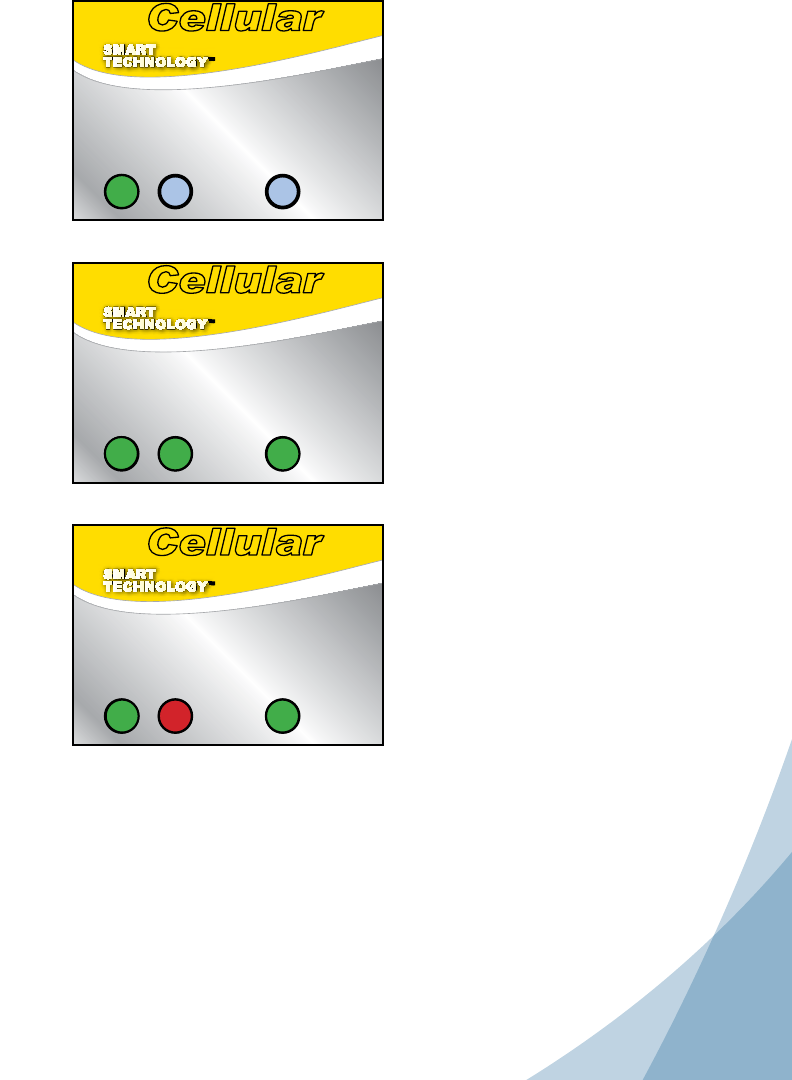
10
Understanding the Amplier Lights
The power light PWR will turn green
when the amplier is successfully
powered up.
When the 800 MHz or 1900 MHz lights
are lit green, the amplier is amplifying
the outside signal.
If one or both frequency lights turn red,
the outside signal may be too strong,
an interfering signal may be present,
or oscillation may be occurring and
the amplier has powered down. For
the case that the outside signal is
too strong, it indicates the signal is
strong enough to operate without
amplication.
If overload does occur, the amplier
will reset automatically. The amplier
checks the outside signal periodically
and adjusts its power for the best
performance.
Wilson
Cellular
TMTM
PWR 800 MHz 1900 MHz
Mobile Wireless
Dual-Band Amplifier
Cellular / PCS 824-896 / 1850-1990 MHz
Wilson
Cellular
TMTM
PWR 800 MHz 1900 MHz
Mobile Wireless
Dual-Band Amplifier
Cellular / PCS 824-896 / 1850-1990 MHz
Wilson
Cellular
TMTM
PWR 800 MHz 1900 MHz
Mobile Wireless
Dual-Band Amplifier
Cellular / PCS 824-896 / 1850-1990 MHz

Wilson® Electronics, Inc.
Phone: 866-294-1660 www.wilsonelectronics.com Fax: 435-656-2432
AIG MW 032 / 01.02.07
Amplier Specications
Dual Band
800/1900 MHz Specications
Model Number 271245
Connectors FME-Male
Impedance (input/output) 50 ohms
Dimensions 5.6 x 3.6 x 1.7 inch or 14.2 x 9.1 x 4.4 cm
Weight 1.44 lbs or 0.65 kg
Frequency 824-894 MHz / 1850-1990 MHz
1Passband Gain (nominal)
800 MHz 50 dB
1900 MHz 60 dB
220 dB Bandwidth (nominal)
800 MHz (uplink/downlink) 53.5 MHz / 47.7 MHz
1900 MHz (uplink/downlink) 86 MHz / 83 MHz
Power output for single cell phone (uplink) 800 MHz 1900 MHz
CDMA +30.9 dBm +30.5 dBm
GSM +30.0 dBm +29.7 dBm
EDGE +30.4 dBm +30.3 dBm
AMPS +30.2 dBm
3Power output (uplink) for multiple
cell phones: Number of
cell phones
Maximum Power
800 MHz 1900 MHz
2 +25.0 dBm +24.7 dBm
3 +21.5 dBm +21.2 dBm
4 +19.0 dBm +18.7 dBm
5 +17.0 dBm +16.7 dBm
6 +15.5 dBm +15.2 dBm
Power output for single received channel
(downlink) 800 MHz 1900 MHz
CDMA +10.0 dBm +9.9 dBm
GSM +11.0 dBm +9.9 dBm
EDGE +10.9 dBm +9.6 dBm
AMPS +10.3 dBm
4Power output for multiple received
channels (downlink). The maximum
power is reduced by the number of
channels:
Number of
channels
Maximum Power
800 MHz 1900 MHz
2 -11.6 dBm -3.1 dBm
3 -15.1 dBm -6.6 dBm
4 -17.6 dBm -9.1 dBm
5 -19.6 dBm -11.1 dBm
6 -21.1 dBm -12.6 dBm
Noise Figure (typical) 3 dB nominal
Isolation > 90 dB
Power Requirements
Amplier Usage 6 V, .5 A - 1.5 A (subject to uplink power)
Notes:
1. Nominal gain is the maximum gain at any frequency in the passband.
Average gains are: 37 dB (800 MHz uplink & downlink) 45 dB (1900 MHz uplink & downlink)
2. Nominal bandwidth is the difference between two frequencies that are adjacent to the passband where the amplication is 20 dB
lower than the passband amplication. One of the frequencies is lower than the passband and the other is higher.
3. The Manufacturer’s rated output power of this equipment is for single carrier operation. For situations when multiple carrier
signals are present, the rating would have to be reduced by 3.5 dB, especially where the output signal is re-radiated and can
cause interference to adjacent band users. This power reduction is to be by means of input power or gain reduction and not by
an attenuator at the output of the device.
4. The maximum power for 2 or more simultaneous signals will be reduced by 6 dB every time the number of signals is doubled.